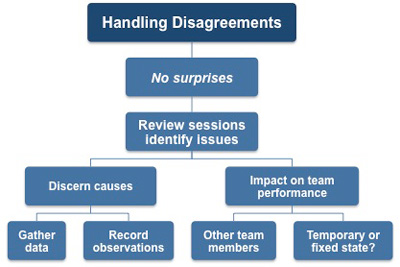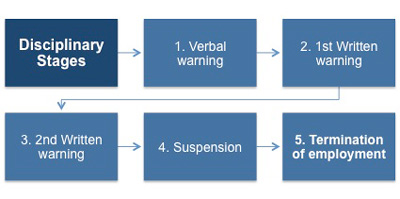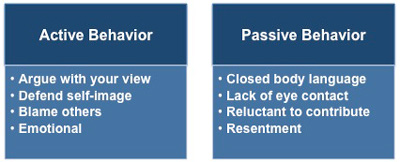Appraisal Discussion Points
Occasionally you will need to deal with a poorly performing individual and in these cases the quality of your preparation will be a major influence on the success or otherwise of the appraisal meeting.
The meeting should never be the first time that you inform them about their poor performance. Your regular review sessions with the person should provide ample opportunity for you to notify them of sub-par performance and to devise a plan to help them get back on track.
However, if this has failed and you have arrived at the appraisal meeting with differences of opinion then you will have to deal with it. The important thing is that these differences do not come as a surprise to either party.
You will need to be able to illustrate their poor performance from the data you have collected. You should also have observations and feedback from third parties that show the team member's lack of competencies or inability to attain his or her goals. It is absolutely vital that this data is both objective and authoritative. You will need to maintain a tight control over this meeting if it is going to be productive and not simply degenerate into an argument about whether or not there is a problem.
If you suspect that the meeting might get heated then it can be a good idea to invite someone from the Human Resources (HR) department to act as a neutral third party and to calm things down if necessary. The presence of a representative from HR can also act to increase the level of formality of the meeting, which is usually a good thing in confrontational situations.
 |
Anyone performing below the required standard will have an impact on the rest of the team and other members may be carrying the extra burden or having to repair damage done. Appraisals and review meetings with other team members should provide data that supports your low performance scores.
The main objective for this meeting is to discover the cause of the poor performance and to assess whether or not this is a permanent or temporary problem. If the low performance is a longstanding issue then you need to devise a plan of action to resolve it.
In some instances, despite your best efforts you may have to instigate disciplinary action. In these circumstances consult your Human Resources representative who can brief you on the current legal procedures and issues, assisting you in how best to address and document this action.
 |
If you find yourself in the situation where you need to initiate disciplinary action against one of your team members you are likely to take the following steps. You need to check with the HR department before you do anything to ensure that you follow the policy and procedure of your organization.
Verbal Warning - always hold this meeting in private and use it as an opportunity to clarify the reasons for poor performance and eliminate any incorrect assumptions. After discussing this situation with the person inform them of what will happen if the situation persists.
First Written Warning - this occurs when the individual does not change their performance and this warning is a written one. It details all aspects of the poor performance supported by the evidence previously discussed with the person and defines what actions are expected in order to address this. In this private meeting you give the individual the opportunity to respond and ensure they understand the letter's meaning before signing it.
Second Written Warning - where the individual does not take the action agreed in Stage 2 and they continue to perform poorly you privately meet them following the same procedure and issue a second warning letter.
Suspension - in circumstances where the problem persists or worsens you are faced with meeting in private with the individual to outline the reasons for and length of the suspension (often 1-3 working days). You must also warn the person that failure to address their continued poor performance or conduct may result in the termination of their contract. This will be written down and signed by them.
Termination - on the individual's return to work if the poor performance or conduct persists despite all the prior stages then you will formally dismiss the individual following your organization's procedures for such an event.
In such meetings you are likely to come across examples of both active and passive behavior and it is important that you know what to expect and how best to handle such behavior.
When there is a disagreement the individual is more likely to actively argue against your interpretation of the event. You need to be aware that you may not be able to talk them around to your point of view. The individual wants to defend their self-image and may attempt to transfer the blame or cause to other members of the team and respond emotionally to the specific examples you provide. This defensiveness is only to be expected and it is acceptable as long as it does not undermine the appraisal process. You can use our Significant Incident Template to help you to monitor and record these specific events in sufficient detail to enable you to have evidence based data to discuss with the individual in your regular reviews or the appraisal.
The person may genuinely feel that there are mitigating circumstances, which you must show that you have actively listened to. Despite this viewpoint you need to ensure that they take on board the fact that there is perceived to be a problem and that it is their responsibility to take the necessary action to improve their performance during the period.
 |
If you are presented with behavior that exhibits passive disagreement - for example, closed body language, lack of eye contact, crossed arms, sitting back in their chair, etc. - it is harder to deal with as the team member is only contributing reluctantly. This type of behavior often occurs where the employee feels as though the manager has no right to be conducting the appraisal.
This may result from a feeling that they are more experienced than you, or because they feel you haven't spent enough time with them or are misinformed about their role. Resentment is at the root of this problem and this is a management problem rather than a problem with the appraisal process itself.
Recognizing the root cause is the first step to fixing this issue. You should ask yourself how you would feel if you were in their position. Be honest about the answer: would you really feel that the person doing the appraisal was sufficiently qualified or appreciated what your day-to-day work involved?
You need to decide the best way to overcome such a situation that may have resulted from a rapid change in organizational structure or an expansion in your department, which the management structure has not yet taken into account. In some circumstances you may want to conduct the appraisal with a team leader as well so that historical data is fully appreciated.
There is a limit to how many people you can appraise properly and if this limit has been exceeded then the appraisal system itself needs to change to take account of this. Whatever the final outcome the individual must feel that their viewpoint has been carefully considered; if not, the appraisal process will be undermined.
You may also be interested in:
Appraisal Meeting Tips | Appraisal Forms Format | Appraisal Meeting Structure | Past Performance Evaluation | Appraisal Goals and Objectives.



